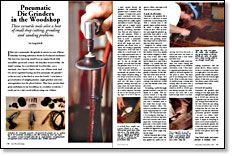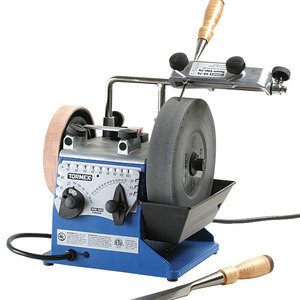Pneumatic Die Grinders in the Woodshop
These versatile tools solve a host of small shop cutting, grinding and sanding problems
Synopsis: Greg Scholl explains how straight grinders, angle grinders, and microgrinders prove their usefulness in his shop. He talks about why pneumatic grinders have an advantage over electric ones, and how their main disadvantage is that they require frequent oiling. He uses them to shape wood without clogging or catching. Scholl uses them for sanding, removing rust from old tools, and cutting and grinding metal – handy when restoring old furniture that has hidden, embedded nails. He also shares important safety tips.
I first saw a pneumatic die grinder in action on one of those Saturday morning, television shows for backyard mechanics. The host was removing metal from an engine block with incredible speed and control. His knuckles weren’t white. He wasn’t cursing. I’m a professional woodworker, not a mechanic, but I knew I had to have one of these tools. And I’ve never regretted buying my first pneumatic die grinder— or the second, or the third or even the fourth. I now have a good selection of straight grinders, angle grinders and even microgrinders (see the photo below). They have proven their great usefulness in my woodshop on countless occasions. I rarely put in a day’s work without using one of them.
I have owned electric die grinders, but pneumatic die grinders have a number of advantages. To begin with, pneumatic machines don’t carry their motors around with them, making them far smaller, lighter and easier to control. They generally spin at a higher speed and are capable of variable speeds, producing smoother cuts. They are also cheaper to buy and maintain. Where a good electric grinder can cost $100 or more, a pneumatic straight grinder should run about $40. Angle and microgrinders are about twice as much. The tooling is generally inexpensive, from less than a dollar for a cutoff wheel or $5 for a high-speed-steel burr to $20 to $30 for a carbide bit. The largest expense is a compressor. To run an average die grinder, you will need one that can generate from 3 to 8 cu. ft. of air per minute at 90 psi.
The only real drawback to pneumatic die grinders is that they require frequent oiling. A few drops of air-tool oil in the coupler end of the tool before each use will keep a good grinder running smoothly for many years. Be aware that the tool will occasionally spit some oil. It rarely happens, but keep an eye on the exhaust port for any signs of oil drool that begins to collect, and wipe it off (but not on your shirt).
From Fine Woodworking #127
For the full article, download the PDF below:
Fine Woodworking Recommended Products

Festool Cleantec CT 26 E HEPA Dust Extractor

Veritas Standard Wheel Marking Gauge

Stanley Powerlock 16-ft. tape measure





















Log in or create an account to post a comment.
Sign up Log in